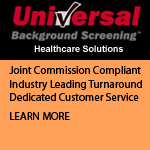| December 16, 2010 | Printer Friendly Version | Advertise | Join ASHHRA | ||

|
PRESIDENT'S MESSAGE
Dear ASHHRA Members, What an interesting end to the year we're having...in the brief pause of the holiday season, we all are pondering: will the economy continue to improve? Will health care reform continue as planned? Will Congress compromise more? And on the local level, each of us is anxiously looking to the new year to see if our budgets will hold, if the census remains steady, and if our quality improves. Throughout all of this, ASHHRA will continue to be there to provide the knowledge and community that we each need to continue to thrive in our careers. Stay tuned, and stay connected! 2011 will be as interesting as 2010 was. Happy Holidays to all! Jeff Payne, SPHR ASHHRA NEWS
LEGAL
WORKFORCE
COMPENSATION
GENERAL HR
BENEFITS
PHYSICIANS
MANAGEMENT & LEADERSHIP
ASHHRA NEWS
LEGAL
COMPENSATION
GENERAL HR
BENEFITS
PHYSICIANS
MANAGEMENT & LEADERSHIP
Too many health care organizations invest significant time and resources in executive leadership development in the abstract hope that someday, those in whom they are investing will emerge as strong leaders and make significant and tangible contributions. In a world of scarce resources, this is no longer viable. Executive development must enable organizations to realize results now, and better prepare our leaders to lead lasting change in the future. Beyond Attract and Retain Health care organizations responded by hustling leaders into more senior positions, sometimes too quickly and hastening to build or buy an executive leadership development (ELD) capability that at minimum provided basic business training and a broader organizational orientation. A 2008 survey of American health systems indicated more than 75 percent of the ELD programs currently in existence were created since 2001, and 94 percent were created since 1998. (McAlearney, 2008)1 In other words, executive leadership development strategies in health care have been driven by a sense of current and future scarcity, with most ELD offerings built principally to attract and retain talent, not necessarily advance immediate organizational objectives. By way of evidence, the most common indicator used by health care organizations to evaluate the effectiveness of leadership development efforts is employee satisfaction. (McAlearney, 2008) Beyond Skill Building Our approach to date has emphasized skill building and elemental business training presuming that the whole would at least equal, if not exceed the sum of the parts; that smart people equipped with the right skills would intuitively know how to lead. A New Approach – Strategy at the Center What might such an experience look like? Looking across the most common elements of executive leadership development, it would be differentiated in a few key areas. Classroom Curriculum: Leading Change v. Building Skill - While it will always be important to help leaders identify and shore up weaknesses where technical skill is concerned – finance, operations, etc. – what ultimately differentiates an organization’s leaders is their ability to lead lasting change. While the most important lessons concerning change management will be learned on the job, a growing number of organizations are bringing a more sophisticated classroom experience to bear in the development of their emerging leaders. Participant-centered learning modalities (e.g. business-school style case studies) and cohort based learning lends itself to the development of cross-functional relationships, the requisite critical thinking skills to understand the complexity of organizational challenges, and practical learning as to situational diagnosis, influence, and persuasion required to lead change. Action Learning: Strategy First – Action or project-based learning is also a staple of executive leadership development. The notion is for emerging leaders to apply classroom or other learning through project-based learning directed at current critical business problems; often involving cross-functional teams of high-potential managers. This is the single best opportunity for deep learning and for emerging leaders to make an immediate contribution to organization goals. Unfortunately this opportunity is often lost because projects are selected for a host of other reasons beyond their strategic impact. For example, a project may be selected because it reinforces a specific classroom lesson or may focus on a competency gap revealed in an individual’s 360-degree assessment. In many cases, because individuals are often asked to identify the project themselves, the project may have marginal strategic relevance. After all, functional leaders will not likely have the organizational perspective to identify projects of maximum strategic relevance. Finally, because projects are assigned on an individual basis, individuals limit the universe of potential projects to those they can complete individually. Best practice organizations begin with the end in mind: first, they identify the strategic work that needs to be executed. Then they build project teams, learning cohorts and curriculum around that work. Finally, they support that work through project-centered coaching. That coaching may be provided through a formal project management function within the organization, or by more senior executives. Some organizations may employ both, with formal project management professionals working more closely with leaders to move projects downfield, while senior executives take on more of a mentoring role. However undertaken, individual learning and organizational results will be best served through a focus on execution, with specific tools and strategies to support that focus. Accountability for Results – As with any organizational priority, stakeholders must be held accountable for results. At the conclusion of a project/development cycle – all stakeholders must be held to account. Best practice organizations accomplish this through a focused 360 degree performance review. Participants are evaluated by coaches and project teammates as to their project performance, and by classmates as to their preparation and participation in class. In turn, participants will evaluate coaches and project management professionals, as well as curriculum and faculty. As with each of the other elements detailed herein, the focus is on strategy first, specifically whether targeted objectives were reached and whether organizational goals were accomplished. ˜˜˜ A curricular focus on leading change combined with a practical focus on strategic application allows organizations in a sense to "extend the executive team," while accelerating emerging leaders’ readiness to assume more senior level responsibilities. Done well, strategic execution becomes the principal means of developing senior talent, and leaders emerge more capable of implementing lasting change. ˜˜˜ Matthew Cornner is the Executive Director of BDC Impact, a provider of strategy-focused executive development solutions for top health care organizations. For more information about strategy-centered leadership development, please go to www.bdcimpact.com or contact Mr. Cornner directly at matt.cornner@bdcimpact.com or 202-255-2184. Bibliography
1 Despite these furious recent efforts, our industry still lags far behind. Just 53% of health systems have a formal ELD programs in place versus 85% of Fortune 500 companies. (Khaliq & Watson, 2010) (McAlearney, 2008) Measured differently, benchmark data on leadership development expenditures from The American Management Association indicates the health-care industry invests just 1.25% of payroll on leadership training and development compared to an industry average of 4% for the top 100 companies. (Melum, 2002) (Groves, 2006) |
ASHHRA Mission To advance the human side of health care, the American Society for Healthcare Human Resources Administration (ASHHRA) leads the way for highly effective, valued, and credible leaders. Contact: ASHHRA FOLLOW US ON |

|

|
 |
155 North Wacker, Suite 400 Chicago, IL 60606 Ph.: 312.422.3720 Fax: 312.422.4577 E-mail: ashhra@aha.org Website: www.ashhra.org |










